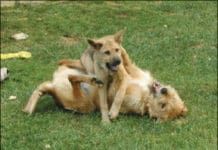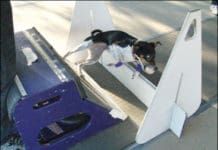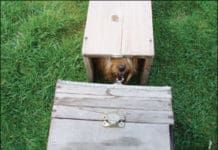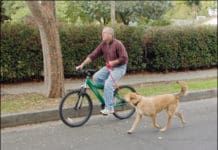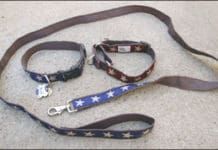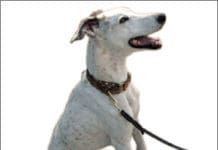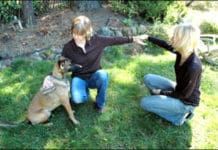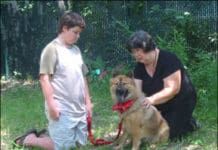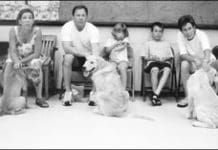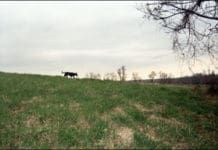Home Search
dog park - search results
If you're not happy with the results, please do another search
Dog Fostering Programs
he was adopted by a perfect family."
High-Energy Canine Competitions
Woof, yap, scream, yodel, bark, yip. Go, go, go!” Dogs on the sidelines and in crates and exercise pens barking at the top of their lungs. Dogs tugging and growling, tugging and growling. Handlers yelling over the din to their teammates. Handlers recalling their dogs over jumps, H-e-r-e! Event officials blowing whistles and announcing the next race over bullhorns or speaker systems, and start-line lights and passing lights flashing on and off. Flyball is a cacophony of sights and sounds. It is exhilarating, over the top, adrenalized hyperstimulation. This is not a sport for the introverted, timid, or sound-sensitive dog or handler. The adrenalin level is off the charts and you can hear that from hundreds of yards away. The first time I experienced flyball was as a spectator at an obedience trial held at a park. Suddenly, shattering the decorum, was an ear-piercing scream followed by rabid barking. Certain that an obedience dog had left the ring and treed a critter, I raced over to watch. No critter. No mayhem. Just flyball. The teams had just set up for their first race and the dogs were ready. I had never seen dogs so keen to get going.
Earthdog, An Underground Dog Training Activity
As long as there have been farmers and hunters, there have been “earth dogs.” Hardy, scrappy little dogs helped hunters tree squirrels, run rabbits to ground, corner foxes in their dens, and clear vermin from dwellings. As often happens, humans found a way to create competitive games from dogs’ natural abilities. For terriers and Dachshunds, a sport is born. Earthdog! Get that rat! As early as 211 B.C., mention was made of tiny rough-coated dogs used to follow animals into their burrows. Later, in the 1576 book De Canibus Anglicis, by Johannes Caius, the use of terriers was described in detail. In 1935, after many years of friends gathering together to test their dogs’ capabilities against those of their friends’ dogs, the Dachshund Club started offering trials modeled after German training for fox and badger hunting. This included building underground tunnels up to 50 feet long, with twists and turns along the way that required dogs to make decisions about which way to go to find their quarry. And it’s dark down there! In 1941 the Sealyham Terrier Club issued the first “working certificate,” which outlined requirements for dogs to search out woodchucks. In 1971 the American Working Terrier Association (AWTA) started artificial den trials in the U.S. By 1994, the American Kennel Club had launched its Earthdog program.
Training Your Newly Adopted Dog
I have had a number of dogs over the years, but Otto is actually the very first dog that I’ve gotten as a co-owner. A former boyfriend paid the $40 or $50 that a Bodega, California, sheep rancher wanted for my heart/soul dog, Rupert, way back in 1989, but the puppy was a birthday present for me; Rupe was always my dog. He stuck close by my side through the breakup of that relationship and the next few, too. When Brian (the man who later became my husband) came on the scene, he and Rupert formed a bond, but still, Rupe was mine. Later, a summer of dog-sitting my sister Sue’s long-haired Chihuahua, Mokie, turned into a several-year stay. Mokie has since gone on to live with my sister Pam, who won’t ever give him up; Brian was more than happy when I did so. He tolerated Mokie, but never fully embraced the idea of a yappy little house-dog, no matter how smart and cute. So, while Brian and I have shared a home since 1996, we have never truly shared full ownership of a dog, like we do now. I selected Otto from a shelter, but Brian was the one who gave the signal that it was time for us to get a dog. When Brian and I got married, I kept my own last name, but Brian wanted to be sure that Otto took his surname, and even made sure the dog’s full name (“Otto Maddock”) was engraved on his ID tag. And Brian has been a real champ about sharing dog-care duties with me.
Nocturnal Dogs
and matching leash all get softer with time and laundering. I like the extra large D-ring for snapping the leash onto.
Increase Your Dog’s Reliability
Behavior professionals often define “reliable” as responding appropriately to the cue at least 80 percent of the time. That means your dog sits at least 8 out of 10 times when you ask him to. It’s unreasonable to expect 100 percent reliability from your dog. It takes commitment to your training program to achieve reliability under a wide variety of conditions. Let’s explore some of the elements that make for true reliability.
Canine Energy Healing Techniques
Energy medicine, once so exotic that it was dismissed out of hand by America’s physicians and veterinarians, is now going mainstream. In addition to the canine therapies described last month, energy healing techniques such as flower essences, animal communication, and kinesiology are used by holistic veterinarians in the U.S. and around the world. Understanding what these therapies are and how they work will help you decide which energy therapies might be appropriate for your canine companion.
Frequently Used Canine Healing Methods for Injured Dogs
We call it the spark of life for good reason. From birth to death, all living creatures generate and transmit energy. Entire healing therapies, some of them thousands of years old, have been built around energy. Once dismissed by Western science as impossible or ridiculous – and still viewed with suspicion by conventional physicians and veterinarians – energy medicine is slowly gaining acceptance in the United States. Several energy therapies are taught in American universities or are used by a growing number of healthcare practitioners. Can energy therapies help your dog? The descriptions and resources provided here may help you decide.
Get Your Puppy Enrolled Into Puppy Training School As Early as Possible
The optimum time to start a puppy’s education is as early as possible: about eight weeks of age. With food treats and clickers as the primary tools in our training arsenal, we can help owners start educating their youngsters at an optimum training age, before pups have had several months of reinforcement for unwelcome and inappropriate behaviors. Paradoxically, some veterinarians still counsel owners to wait until their new puppies are six months old and “fully vaccinated” to take them to training class. Unfortunately, this advice is just as outdated as the use of choke chains in puppy classes! It’s true that you shouldn’t wantonly expose your pup to high-risk dog populations; you should never take him to a dog park, or let him play with stray dogs on the street. But the risk of contracting an infectious disease in a controlled setting, with other healthy puppies, is quite low.
Teach Your Dog to Run Off Leash
My dog, Molly, runs like the wind. When I see her run, it is impossible for me not to appreciate the beautiful, graceful way she moves. She is also a rescue dog, with a number of canine behavior problems caused by severe neglect in her first few months. The combination of a bad environment and a fearful temperament created a dog who protects herself by aggressively warning off any stranger. An occasional off-leash run is one of the few ways I can give Molly enough exercise to keep her calm and make her unequivocally happy, and this practice is improving our relationship. It’s not without some stress, however.
Good Dog Walking
Dog owners often bemoan the paucity of public places in our society where their dogs are welcome. We band together and lobby mightily to secure small spaces in our communities for dog parks. We struggle to preserve dog-use rights in public common areas. And while I share the dismay over the shrinking access for our canine companions, I know that to a large degree we’ve brought it on ourselves by our collective carelessness about proper public and leash-walking etiquette.
Shots Fired: Professional veterinary associations call for a reduced canine vaccination protocol
In the past decade, the veterinary profession’s overall attitude toward vaccination has evolved to a point that can be tentatively termed progressive. In 2002, the American Veterinary Medical Association issued a policy statement that urged veterinarians to “customize” vaccine protocols for individual patients, since there is “inadequate data to scientifically determine a single best protocol” for initial or repeat vaccinations. A year later, the prestigious American Animal Hospital Association (AAHA) released its landmark canine vaccination guidelines, which were updated in 2006.


